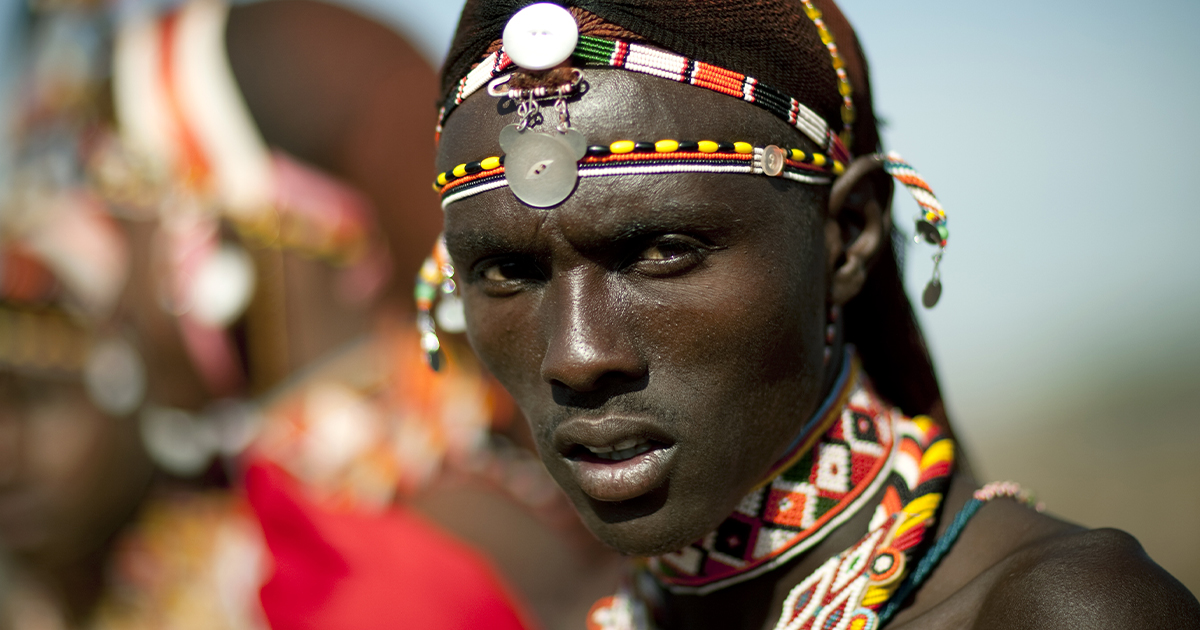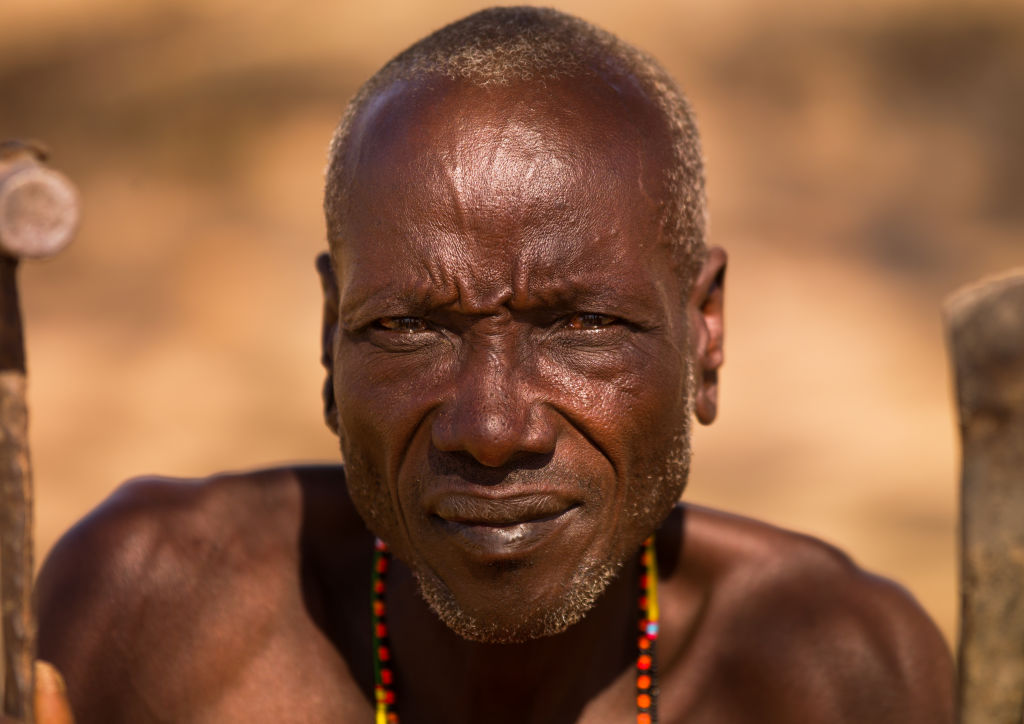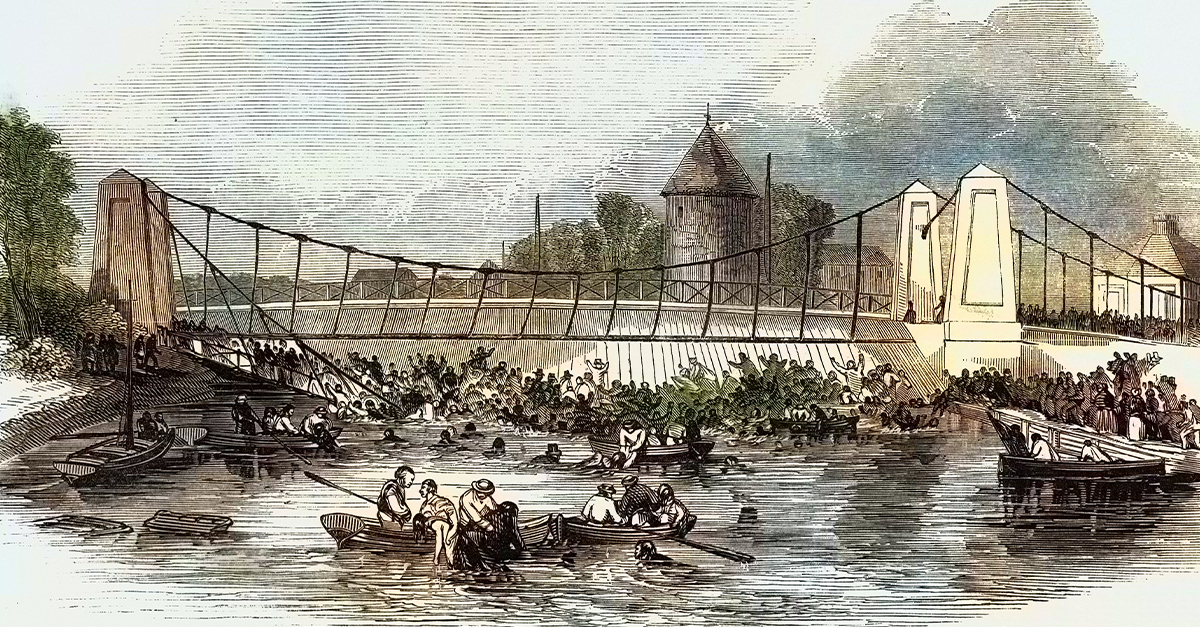The Samburu People of Kenya
In the dry forests of northern Kenya lives a tribe untouched by modern-day civilization. The Samburu are one of the last few tribes in the world who still live a primitive lifestyle, sleeping in mud huts and gathering food from their surroundings.
But their traditional customs don’t stop there—one of their most important rituals also happens to be extremely controversial, and even unlawful.
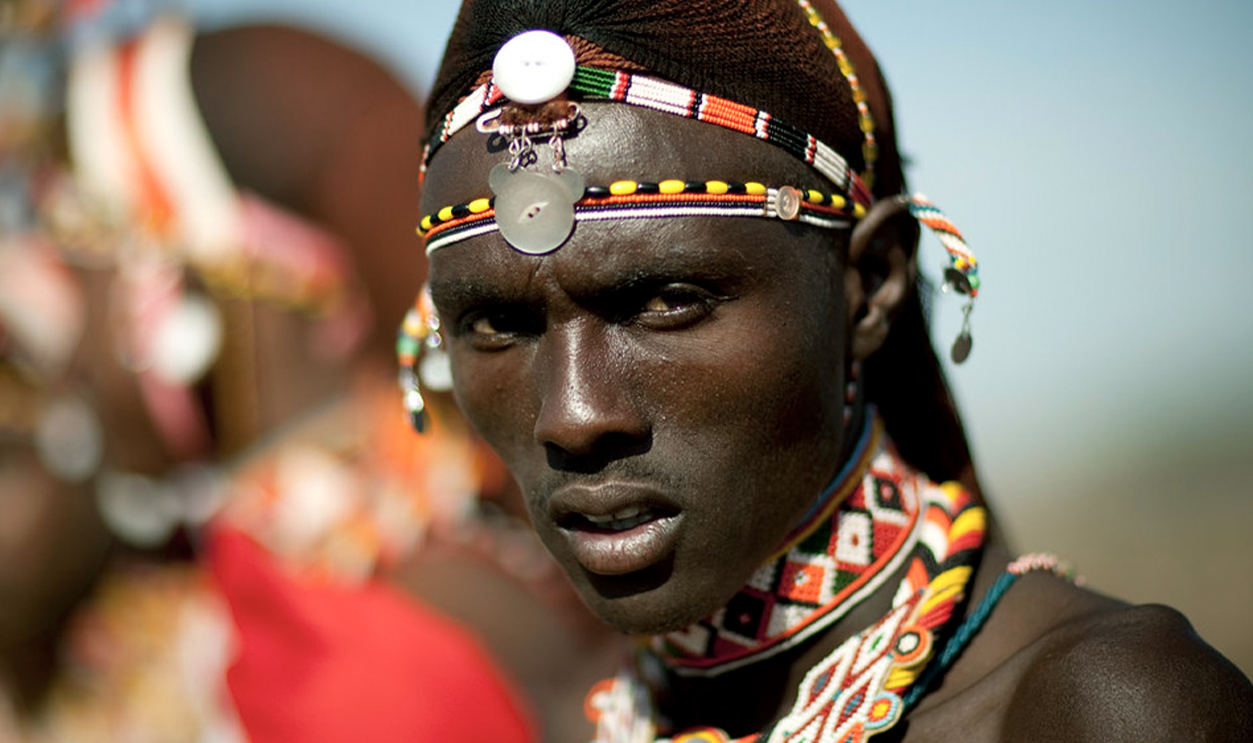
Who Are They?
The Samburu people are a semi-nomadic tribe living in northern Kenya. They’ve been around for centuries, but haven’t given in to modern colonization—despite constant pressure from the Kenyan government.
Today, their population numbers over 300,000—and the majority of them continue to live an extremely traditional and primitive lifestyle.
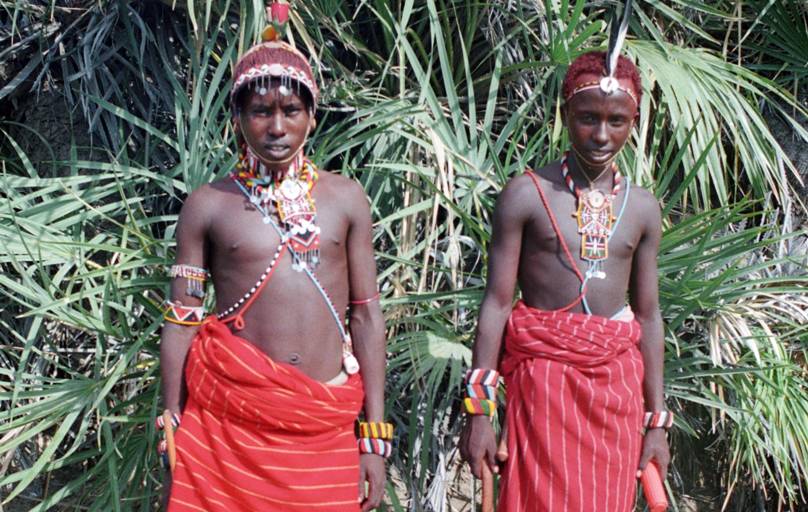 Виктор Пинчук, CC BY-SA 4.0, Wikimedia Commons
Виктор Пинчук, CC BY-SA 4.0, Wikimedia Commons
What Language Do They Speak?
The Samburu speak the Samburu dialect of the Maa language—a Nilotic language which is also spoken by several other tribes in the area. While they may share the language, it is widely believed that the Samburu are a distinct tribe, completely separate from their tribal neighbors—particularly because of their traditional live-off-the-land lifestyle.
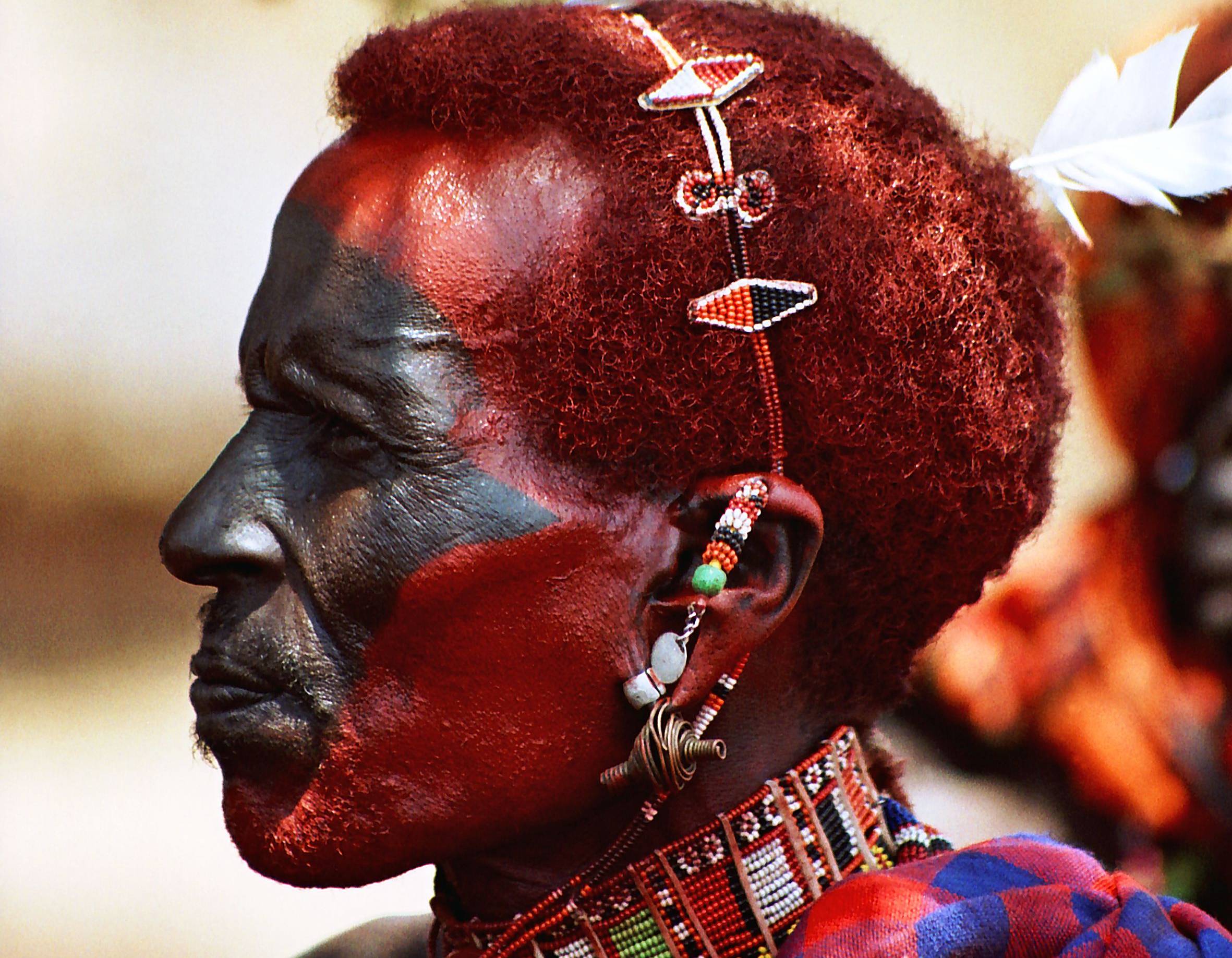 Dr. Ondřej Havelka (cestovatel), CC BY-SA 4.0, Wikimedia Commons
Dr. Ondřej Havelka (cestovatel), CC BY-SA 4.0, Wikimedia Commons
What Does Their Name Mean?
The Samburu refer to themselves as Lokop or Lokiop—a term with varied interpretations among the Samburu, but that many believe loosely translates to “owners of the land”.
They are also sometimes called the “Butterfly People” because of the intricate beadwork designs on their clothing, which resemble the patterns on butterfly wings.
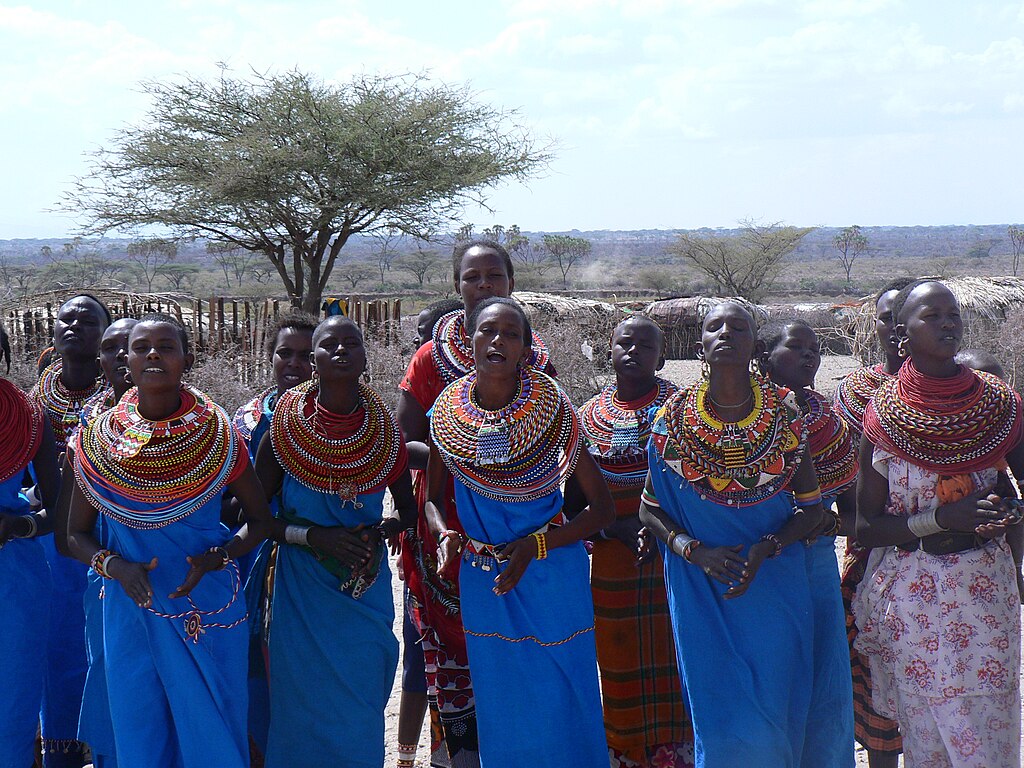 Wouter van Vliet, CC BY 2.0, Wikimedia Commons
Wouter van Vliet, CC BY 2.0, Wikimedia Commons
Where Do They Live?
The Samburu tribe lives in Samburu County in northern Kenya. They refer to their homeland as Woto, which means “north”. Their land, while mostly hot and dry, is known as a geographically fascinating area—but in this case, fascinating can also mean extremely dangerous.
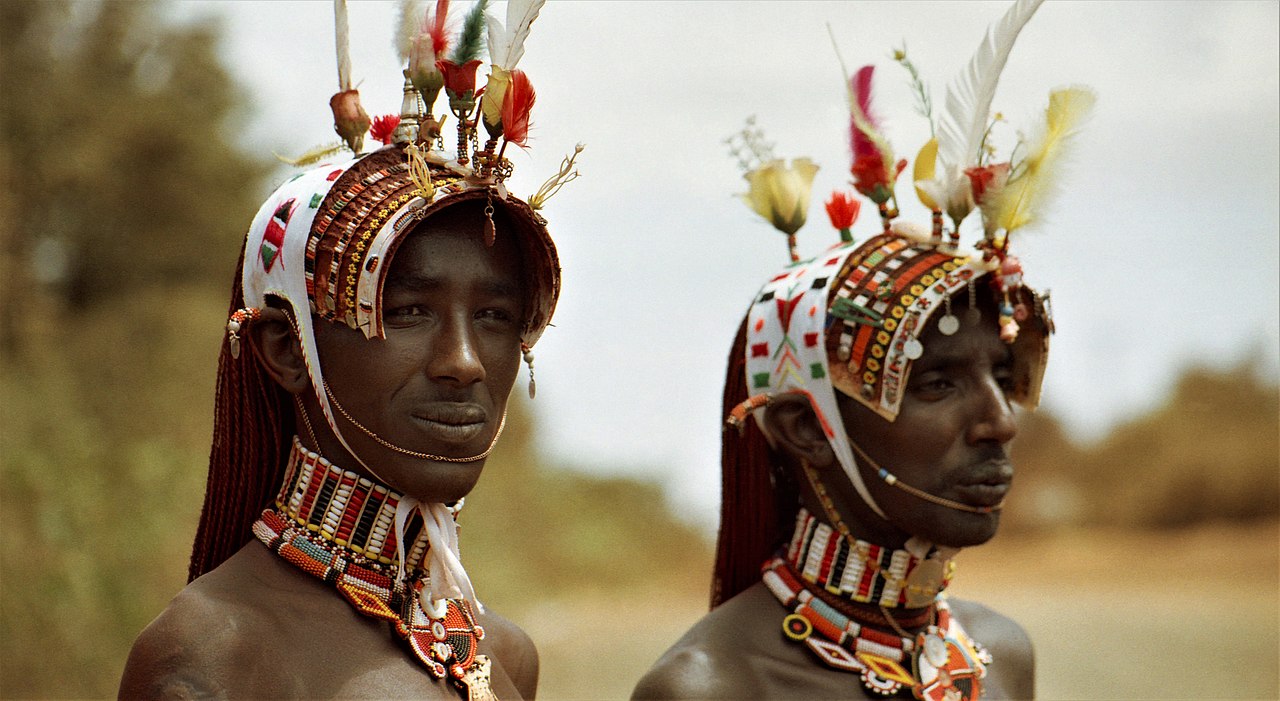 Dr. Ondřej Havelka (cestovatel), CC BY-SA 4.0, Wikimedia Commons
Dr. Ondřej Havelka (cestovatel), CC BY-SA 4.0, Wikimedia Commons
Who Do They Share The Land With?
The Samburu live in areas surrounding the Samburu National Reserve, which is a wildlife conservation area filled with remarkable wildlife including giraffes, zebras and elephants.
And don’t forget those at the top of the food chain: hippos, rhinos, crocodiles, lions, cheetahs, leopards, buffalo, and more. And as beautiful as these beasts may be, they are among the Samburu’s top predators—especially when it comes to their food sources.
 Weldon Kennedy, CC BY 2.0, Wikimedia Commons
Weldon Kennedy, CC BY 2.0, Wikimedia Commons
What Do The Samburu Eat?
Considering they are a semi-nomadic tribe, the Samburu are still very traditional and have not parted ways with old customs—including how they nourish themselves.
Aside from gathering wild produce, they primarily herd cattle, but also keep sheep, goats, and camels—all of which look tasty to the predators next door. The Samburu must move around often enough to sustain their livestock, and to keep them safe.
While their food sources aren’t anything out of the ordinary, what they drink might shock you a little.
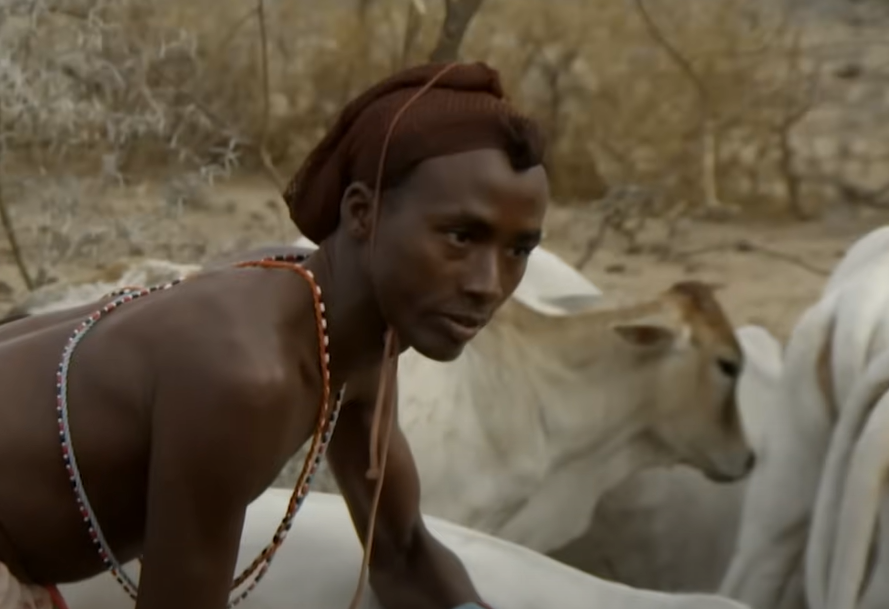 National Geographic, Primal Survivor (2016-)
National Geographic, Primal Survivor (2016-)
What Do They Drink?
The Samburu are highly dependent on their livestock for survival, which means nearly nothing gets wasted. And since water can be scarce at times, milk is highly important. They drink it fresh or fermented. Actually, “ripened” milk is considered superior.
But the sour milk isn’t the shocking part.
 National Geographic, Primal Survivor (2016-)
National Geographic, Primal Survivor (2016-)
What Else Do They Consume?
Milk isn’t always enough to sustain the whole tribe. When water is readily available, many Samburu drink tea using various herbs and roots they gather. But when they need more, they turn to their animals.
Blood from their cows is commonly used as a drink alternative. Sometimes it is drained directly from the cow right into their cups. Other times, they use the blood to make meals. There are at least 13 ways that blood can be prepared.
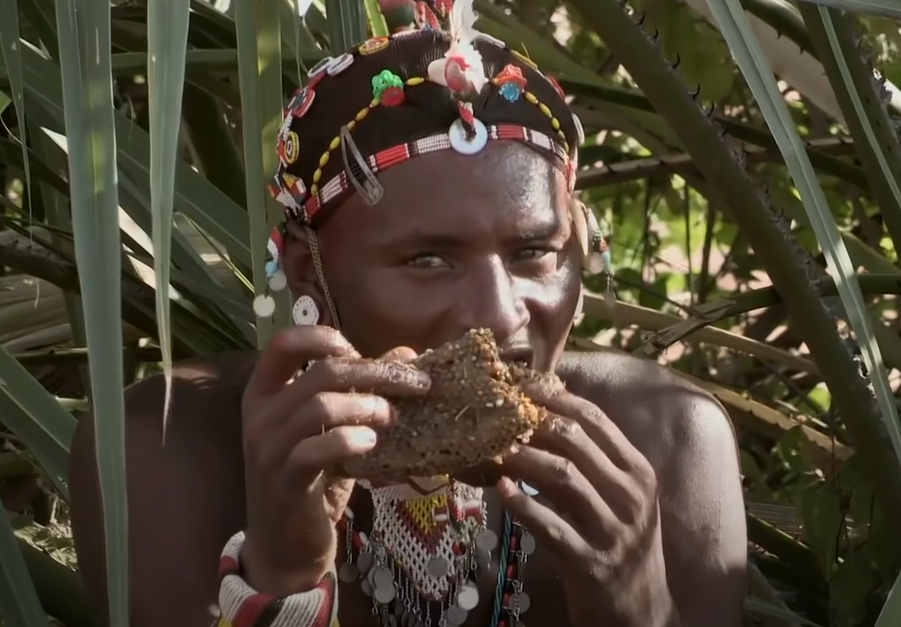 National Geographic, Primal Survivor (2016-)
National Geographic, Primal Survivor (2016-)
How Do They Source Water?
Music, dancing, and singing are all very important parts of the Samburu culture. Aside from singing and dancing at their ceremonies, Samburu people will also sing as they gather water for their livestock.
Every day during the dry season, Samburu men bring their livestock to dry riverbeds where they have hand-dug several wells. They then form a human chain down into the wells and pass buckets of water up and along the human chain to pour into troughs for the animals.
During this activity, the men sing a particular song that helps them keep rhythm and stamina. Keeping their livestock well is of utmost importance—especially one particular animal.
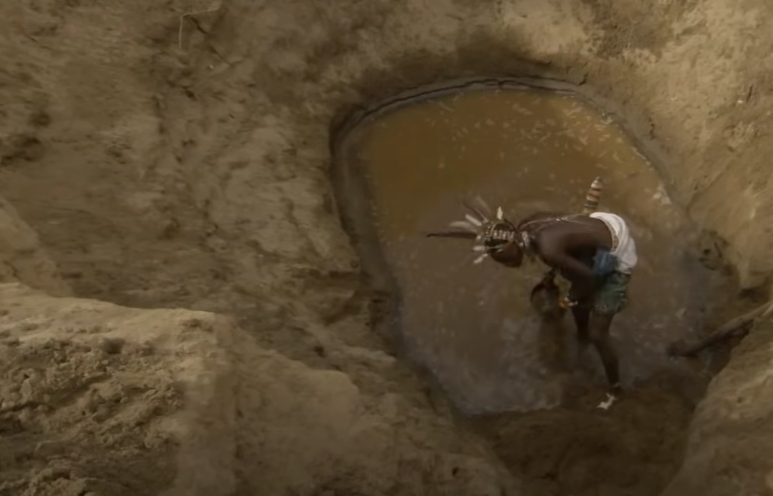 National Geographic, Primal Survivor (2016-)
National Geographic, Primal Survivor (2016-)
Which Animal Do The Samburu Highly Value?
In the Samburu culture, the camel is highly valued. Historically, they would use camels for their milk, meat, wool, skin, and dung. Camel dung is used to start fires, and to keep bugs away.
Camel milk was the most common milk they drank (and still is today), and they still often use the skin for making clothes, tents, floor mats, and ropes.
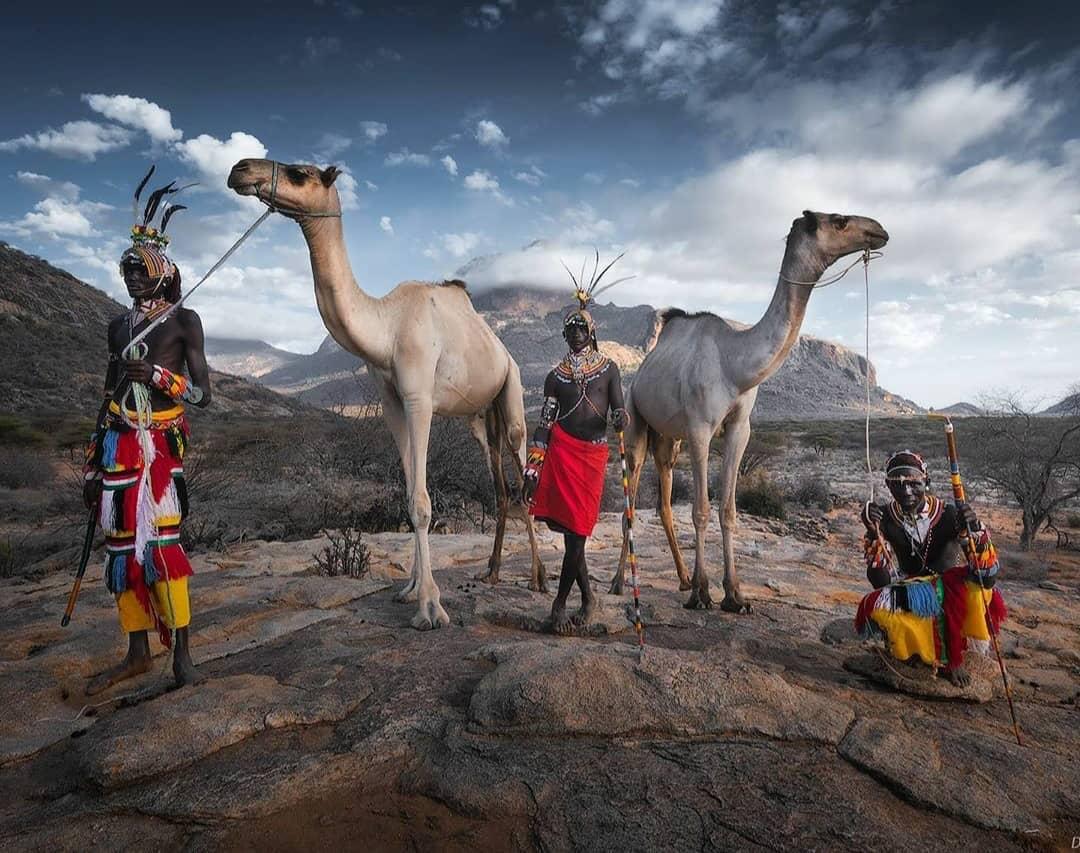 Spidylolo, CC BY-SA 4.0, Wikimedia Commons
Spidylolo, CC BY-SA 4.0, Wikimedia Commons
What Do They Wear?
The Samburu are a colorful group of people. Women’s clothing is made from a colorful cloth (usually red) that is wrapped like a skirt and has a white sash. They will then accessorize with many colorful beads and various kinds of handmade jewelry.
Men often wear a pink or black cloth wrapped around their waist, and also adorn themselves in beaded jewelry.
 Dr. Ondřej Havelka (cestovatel), CC BY-SA 4.0, Wikimedia Commons
Dr. Ondřej Havelka (cestovatel), CC BY-SA 4.0, Wikimedia Commons
How Do They Wear Their Hair?
Samburu men (especially warriors) typically wear their hair in long braids, which they shave off when they become elders. Some of them color their braids using red ochre.
Unlike many Western cultures, Samburu women keep their heads completely shaved.
The most important part of their attire, though, is their beadwork. Not only is it extravagant—the intricate designs have age-old meanings, too.
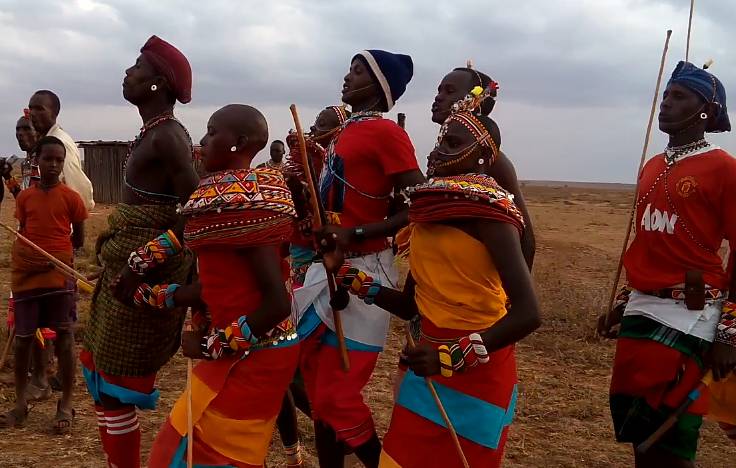 Wanjikuthekenyangirl, CC BY-SA 4.0, Wikimedia Commons
Wanjikuthekenyangirl, CC BY-SA 4.0, Wikimedia Commons
What Does Their Beadwork Represent?
The Samburu use different beaded necklaces to represent social status. Young boys wear a different color than the “warrior” men, and elders wear fewer necklaces and duller colors than the younger generations. The same is said for women.
Different colors and designs indicate social status and marital status—and their headbands tell an important story, too.
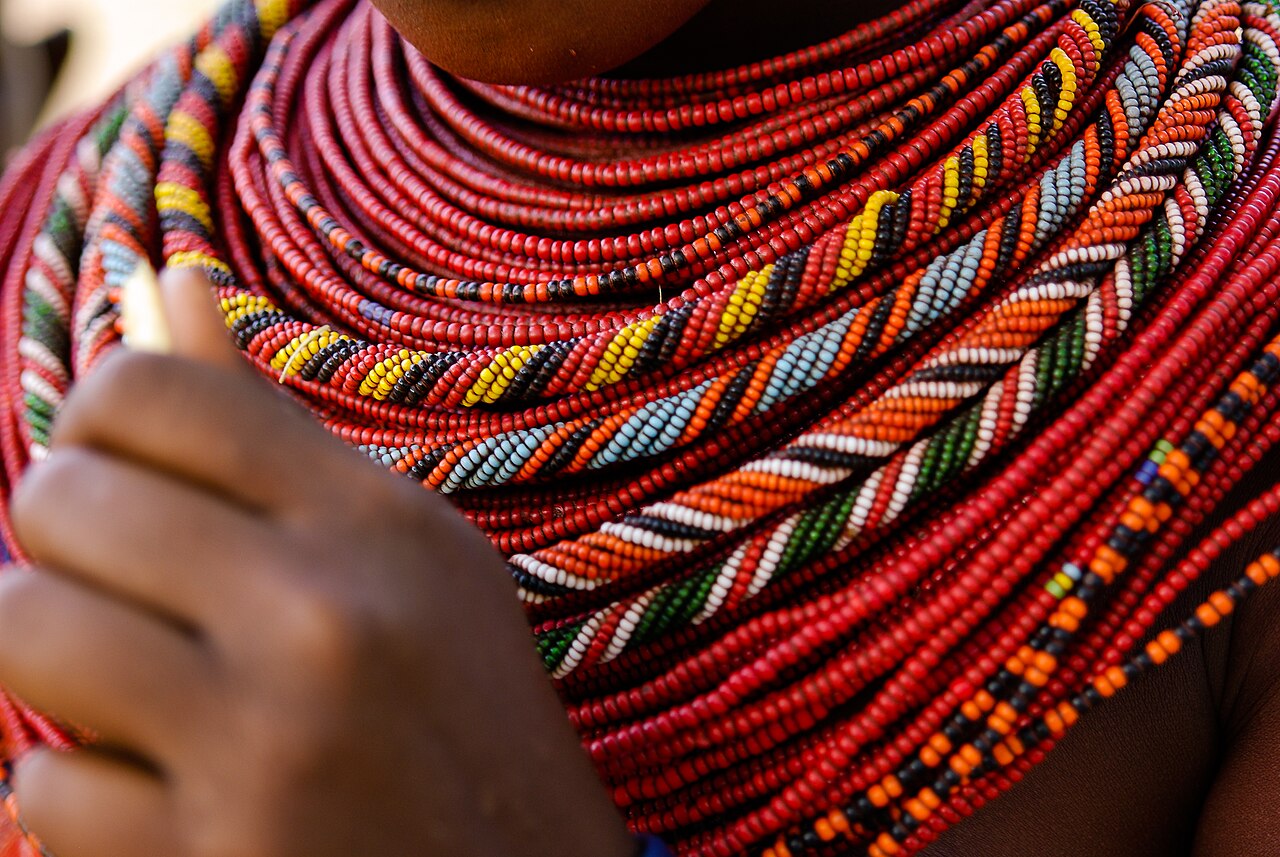 Redemption93, CC BY-SA 4.0, Wikimedia Commons
Redemption93, CC BY-SA 4.0, Wikimedia Commons
What Do Their Headbands Mean?
Women’s headbands symbolize beauty in the brain—which may signify that the woman is intelligent as well as beautiful. But some of their headbands have larger centerpieces than others. This is because in the Samburu tribe, men are allowed to have multiple wives. The size of the centerpiece on their headband signifies whether they are a first, second, or third wife.
While the beaded accessories can often overwhelm them—there is one very important rule the Samburu must follow regarding their beads.
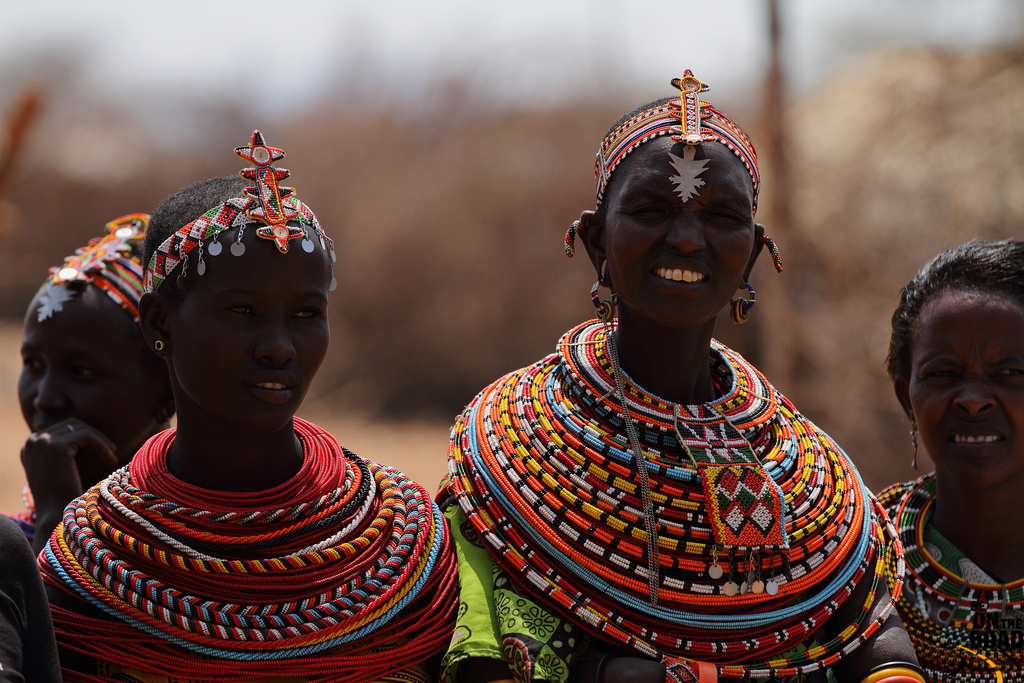 Sankara Subramanian, CC BY 2.0, Wikimedia Commons
Sankara Subramanian, CC BY 2.0, Wikimedia Commons
Do They Ever Take Their Jewelry Off?
The Samburu people never take their jewelry off—even though it looks like it could be uncomfortable to sleep in. For the most part, they are not actually allowed to, unless a change is necessary. Sometimes, women will join their earrings to their necklaces as a way to prevent them from getting lost.
Losing an earring symbolizes a very bad omen—especially since they get their earrings on their wedding day.
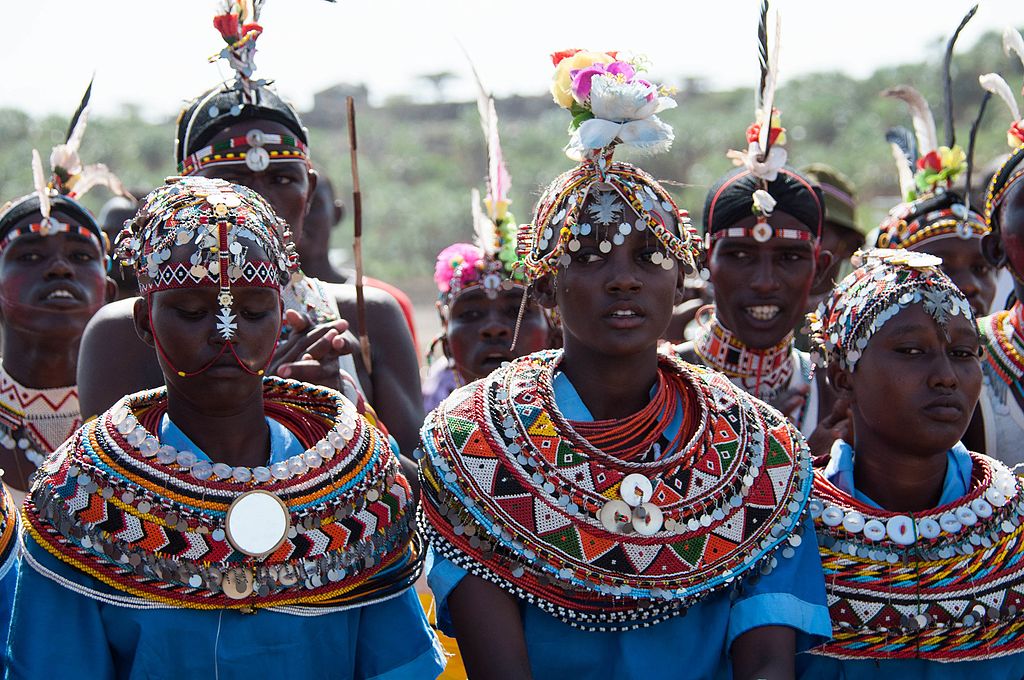 Marta Panco, CC BY-SA 4.0, Wikimedia Commons
Marta Panco, CC BY-SA 4.0, Wikimedia Commons
What Is Marriage Like For The Samburu?
Marriage is arranged by the elders. After the girls have completed the necessary ceremonies and rituals, they become eligible for marriage. Sometimes, girls as young as 12 are married to men who are old enough to be their grandfathers—and who already have other wives.
Men are only eligible for marriage after age 30, when they have completed their warrior training—but then they have to have something to give.
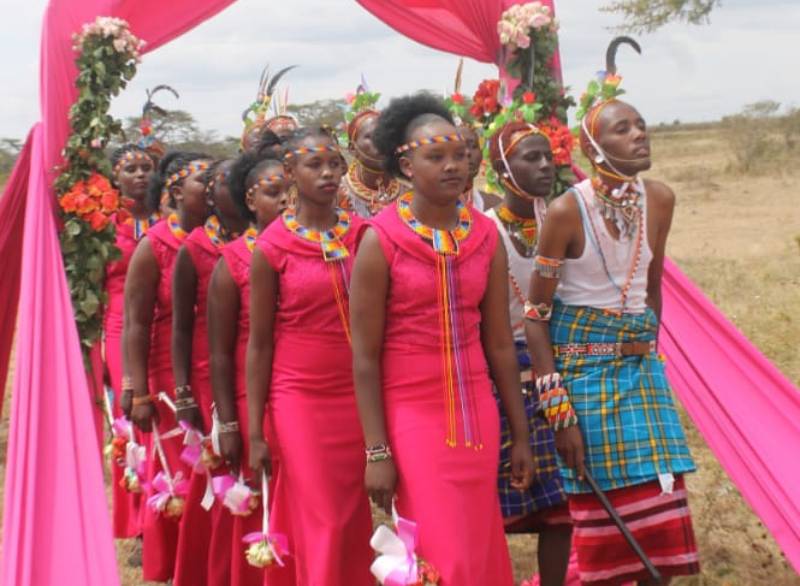 Gracenaisimoilema, CC BY-SA 4.0, Wikimedia Commons
Gracenaisimoilema, CC BY-SA 4.0, Wikimedia Commons
What Does Marriage Entail?
In order for a man to marry, he has to be able to provide a dowry, which includes several kinds of livestock (cows, goats, camels). There must be enough livestock given for the bride’s family, as well as for the bride to still have at her new home. Each new wife requires another dowry—which is often why the older, more established men have multiple wives.
Even so, now-a-days, Samburu men recognize that more wives equals more children, and more mouths to feed—and so many men stop at 2-3 wives.
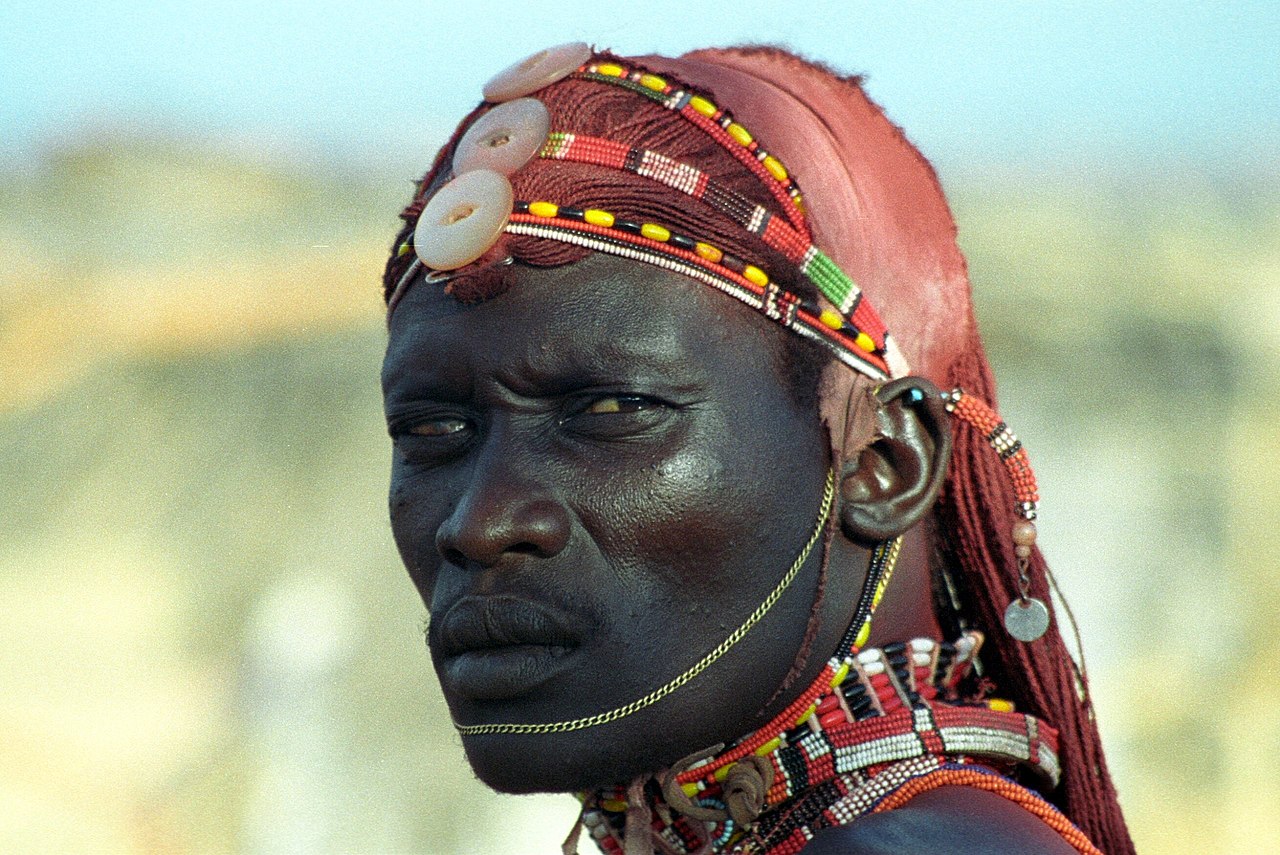 Walter Callens (Retlaw Snellac), CC BY 2.0, Wikimedia Commons
Walter Callens (Retlaw Snellac), CC BY 2.0, Wikimedia Commons
How Many Children Do They Typically Have?
In a Samburu marriage, the women are obligated to produce as many children as possible—for the sake of their population.
Because of this, husbands often look the other way when their wives have affairs. Any pregnancy that results from their wives’ actions becomes another member of the tribe, and so they raise the child as their own regardless.
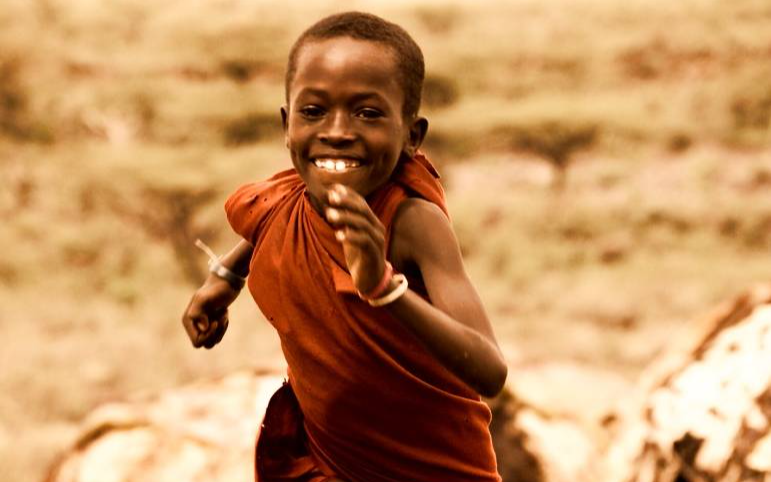 Erik (HASH) Hersman, CC BY 2.0, Wikimedia Commons
Erik (HASH) Hersman, CC BY 2.0, Wikimedia Commons
What Are Their Homes Like?
The Samburu typically pack up and move every few weeks to find fresh grazing grounds, so their shelters are typically very temporary. The huts range in size from very small to relatively large. They are made using sticks, animal hide, mud, and grass mats strung over wooden poles.
Usually, a fence is quickly built around the huts for added protection from wild animals. And that’s not the only way they protect themselves.
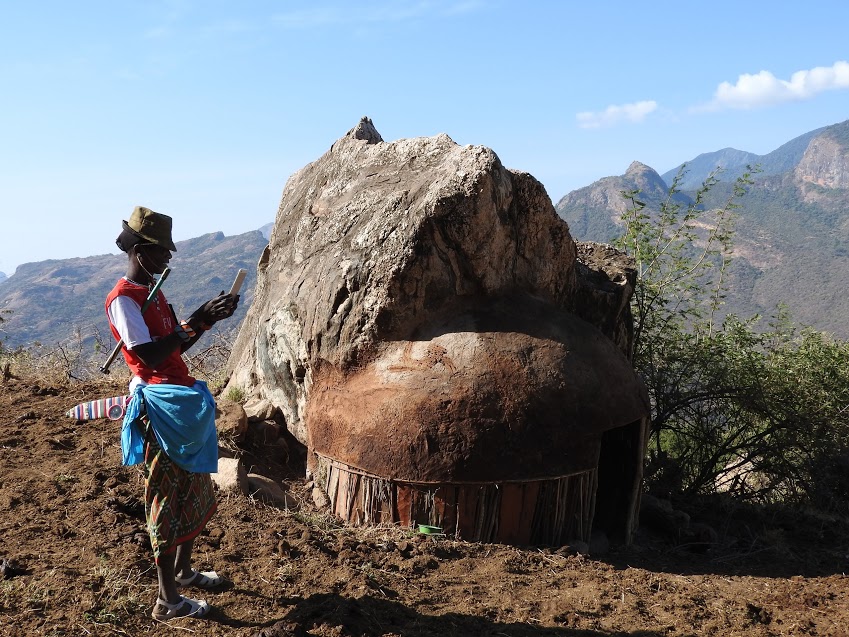 Micleone88, CC BY-SA 4.0, Wikimedia Commons
Micleone88, CC BY-SA 4.0, Wikimedia Commons
What Are Their Settlements Like?
The nomadic lifestyle is a risky one, especially in Africa. So, although they travel a lot, they do so in groups. Each Samburu settlement consists of about 5-10 families. This number is large enough for protection, and small enough to keep the frequent moves easy.
And of course, each tribe member has a job—which is absolutely essential to their survival.
 SHOCKING TRUTH About SAMBURU Tribe., AfroArtista Films
SHOCKING TRUTH About SAMBURU Tribe., AfroArtista Films
What Are Their Gender Roles?
Samburu women are typically responsible for gathering vegetables and roots, collecting water and supplies, and caring for the children. The girls usually help their mothers with domestic chores.
Men are the warriors and protectors. They build shelters and fences, look after the livestock, and are responsible for the overall safety of the tribe.
And the elders—well, they have the most important role of all.
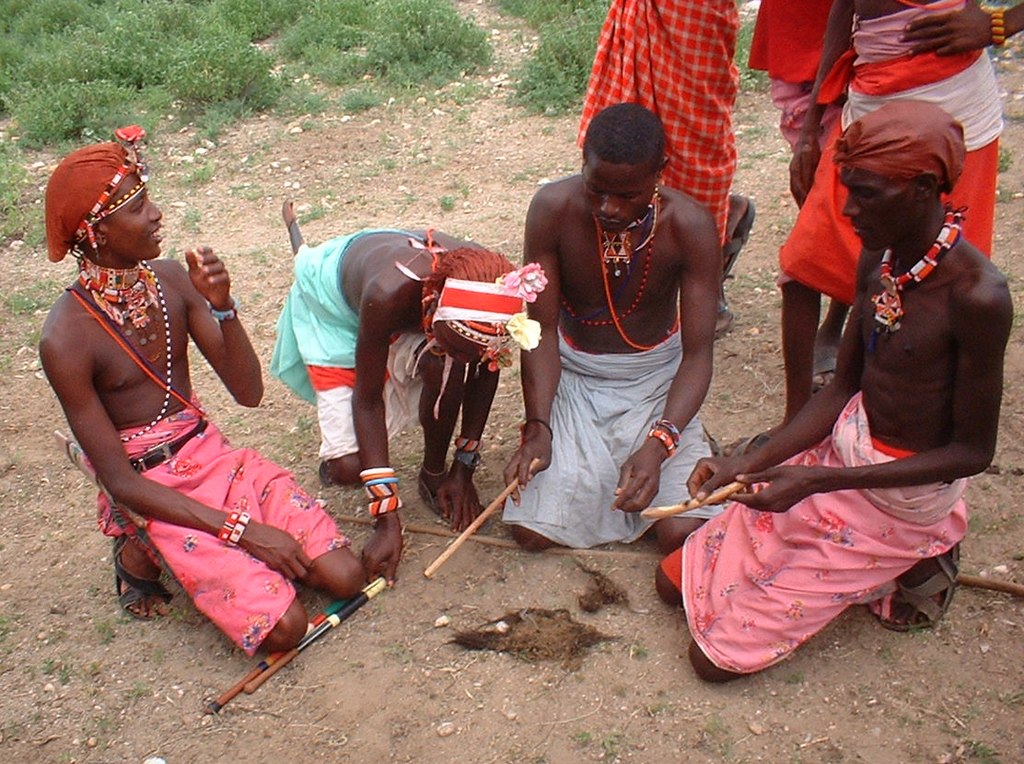 User:Moongateclimber, CC BY-SA 3.0, Wikimedia Commons
User:Moongateclimber, CC BY-SA 3.0, Wikimedia Commons
What Are The Roles Of The Elders?
The Samburu people are a gerontocracy—meaning they are ruled by the elders. The elders are the leaders, and they make all the important decisions, especially when it comes to ceremonies and traditional rituals.
This governance stems from the belief that elders have the ability to lay curses upon those who may show disrespect—and there’s one particular group who gets all the attention.
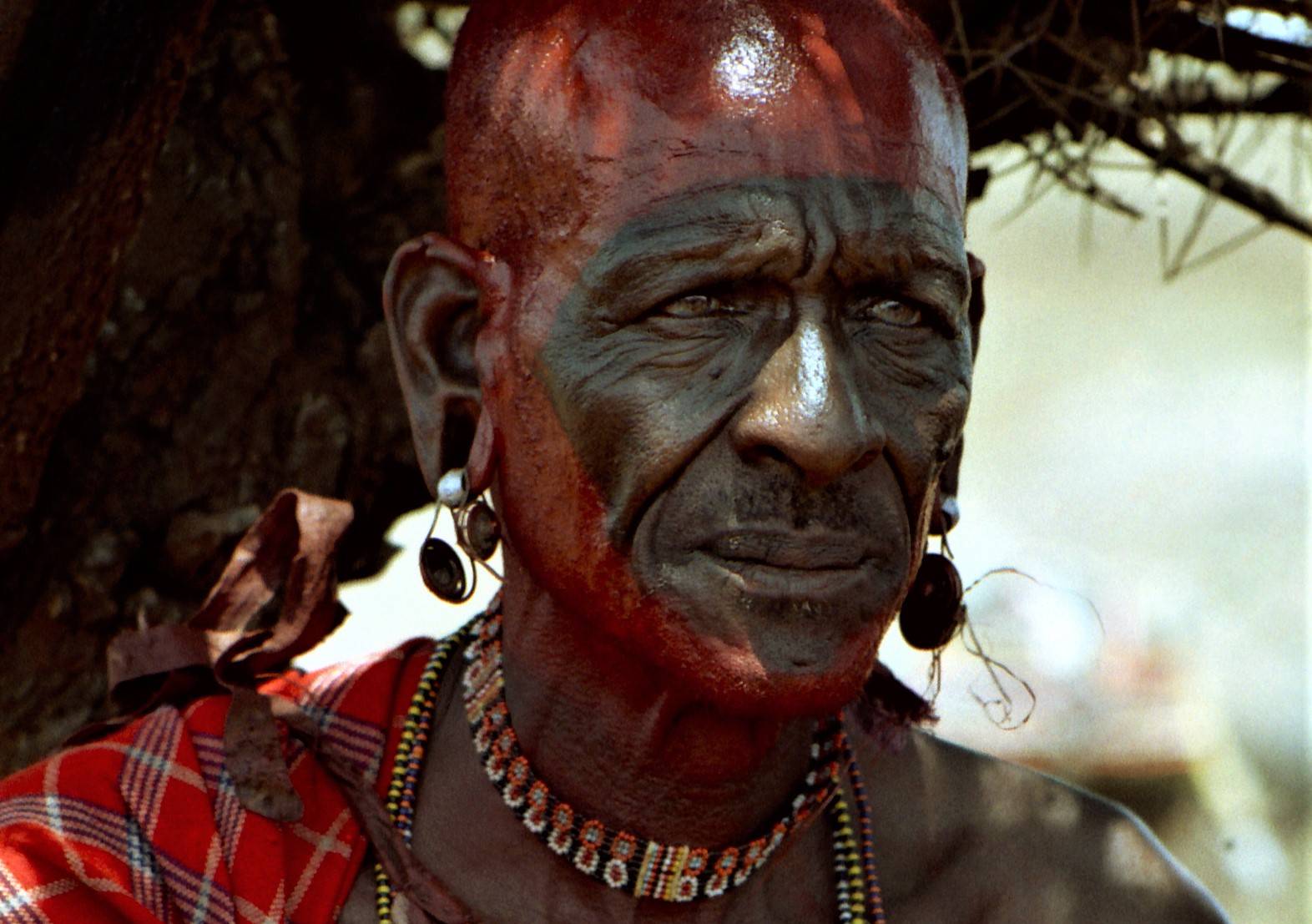 Dr. Ondřej Havelka (cestovatel), CC BY-SA 4.0, Wikimedia Commons
Dr. Ondřej Havelka (cestovatel), CC BY-SA 4.0, Wikimedia Commons
Who Do The Elders Focus On?
Young, unmarried Samburu men are often the troublemakers of the group. Aside from being involved in gang feuds between clans, there is usually widespread suspicion that these bachelors partake in adultery with the wives of older men, and then loot their livestock.
When something like this happens, the elders turn to the curse.
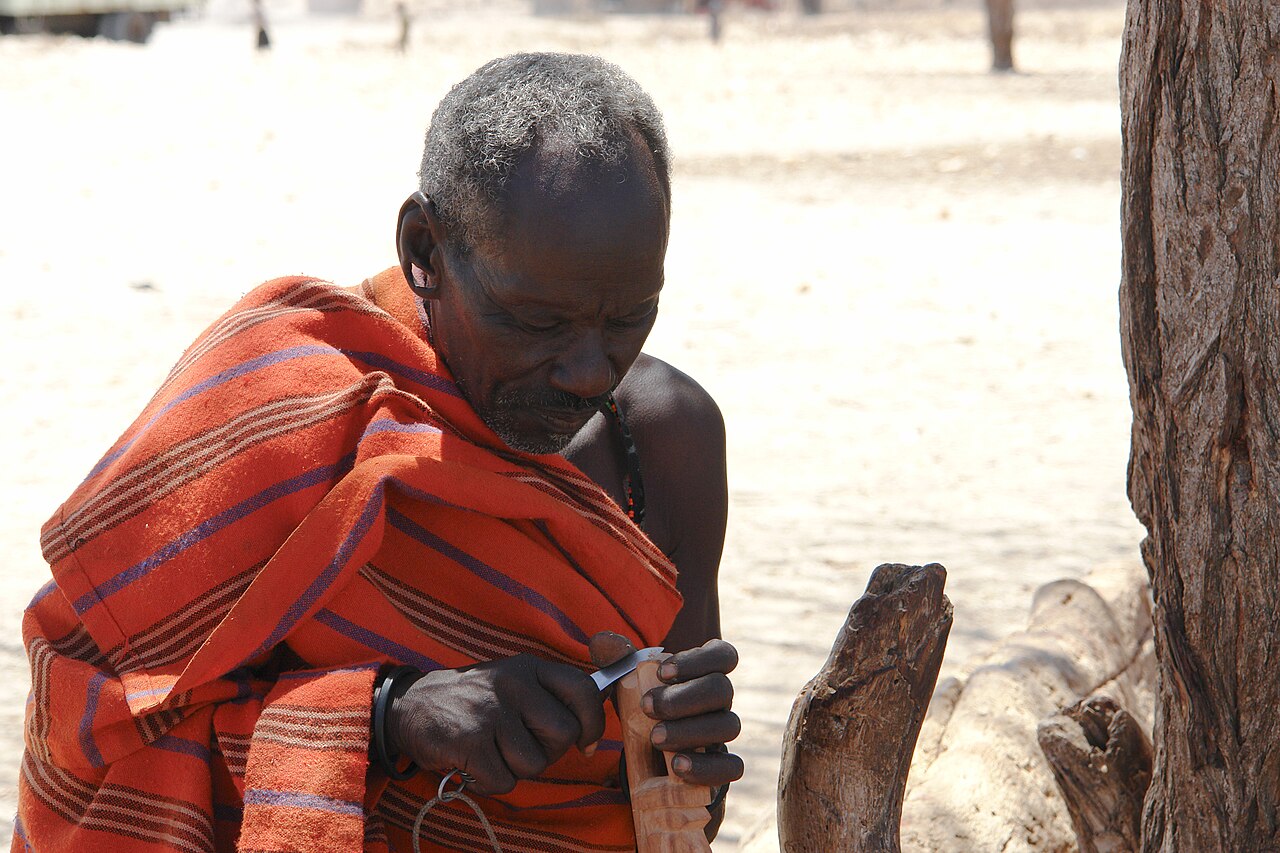 Filiberto Strazzari, CC BY 2.0, Wikimedia Commons
Filiberto Strazzari, CC BY 2.0, Wikimedia Commons
What Is The Curse?
The Samburu believe that God—whom they call Nkai—offers them protection from the hazards of their existence. But God can also dish out punishment if an elder curses a junior without enough reason. So basically, while the youth may be causing all the trouble, God usually has their back.
 Antony Trivet, CC BY-SA 4.0, Wikimedia Commons
Antony Trivet, CC BY-SA 4.0, Wikimedia Commons
What Happens When An Elder Gets Angry?
If an elder becomes angry with a youth, their anger is seen as an appeal to God, and then God determines whether or not a curse is justified. The youth may be able to make up for their disrespect by apologizing and making offerings to those they hurt, which often restores God’s protection.
Usually, the curse is reserved for serious cases of disrespect only.
What Other Power Do Elders Have?
The Samburu elders basically hold the power to decide what their people do and when, including when they can get married, how many wives they can have, and one very important cultural rite—when boys and girls are ready to become men and women.
Adolescence is a hot topic in the Samburu culture—and it involves a process that many Americans find extremely controversial.
 Max 254 writer, CC BY-SA 4.0, Wikimedia Commons
Max 254 writer, CC BY-SA 4.0, Wikimedia Commons
What Happens During Adolescence?
In the Samburu culture, entry into womanhood and manhood is marked by a practice that is extremely controversial around the world today, especially for women. This very traditional tribe practices both circumcision and female genital mutilation—which actually became unlawful in Kenya in 2011.
Boys get circumcised in their teenage years, and most girls are subjected to genital cutting before marriage.
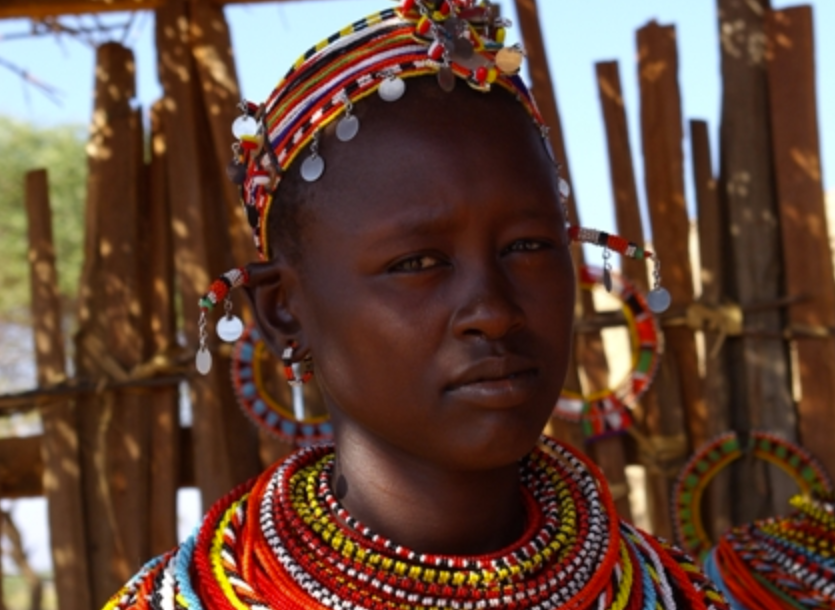 Jean Crousillac (Manta Productions), CC BY-SA 4.0, Wikimedia Commons
Jean Crousillac (Manta Productions), CC BY-SA 4.0, Wikimedia Commons
What Happens To The Boys?
All Samburu boys between the ages of 15 and 30 are traditionally known as Morans. After the circumcision ceremony, the boys enter the age grade “moran”—which means “warrior”. They then move to a separate living quarter in the forest where they learn tribal customs that support strength, endurance, and courage.
But that's not all they do.
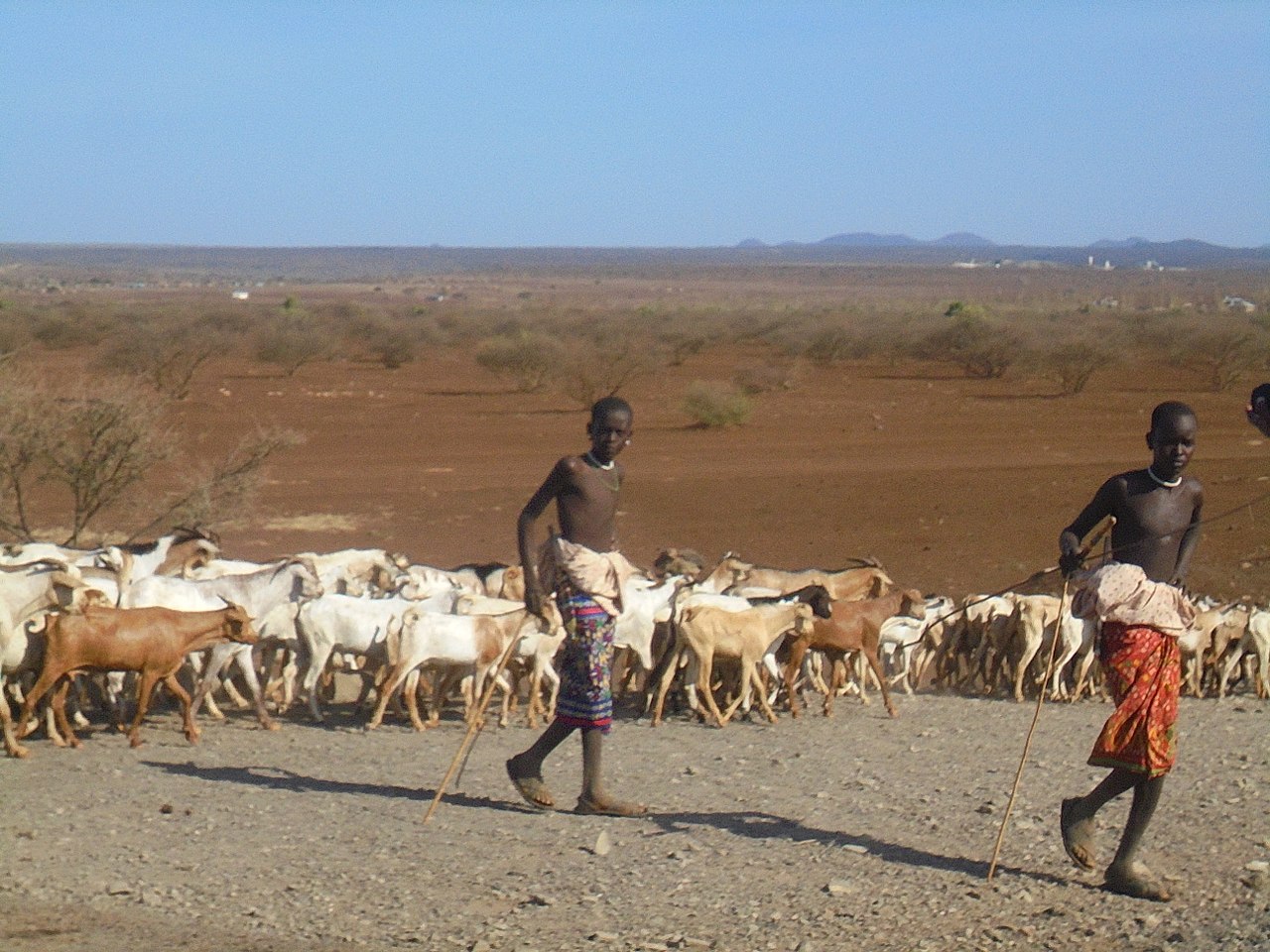 Sangonda, CC BY-SA 4.0, Wikimedia Commons
Sangonda, CC BY-SA 4.0, Wikimedia Commons
What Else Do The Boys Do?
Aside from spending the next 15 years living in a separate area, this is also when the boys will stop cutting their hair and allow it to grow so they can braid it. They will often color it red and decorate their bodies with necklaces and feathers. They have now officially entered manhood. Once they reach age 31, they graduate to junior elder.
The girls go through the same ritual, entering womanhood—but it happens much sooner.
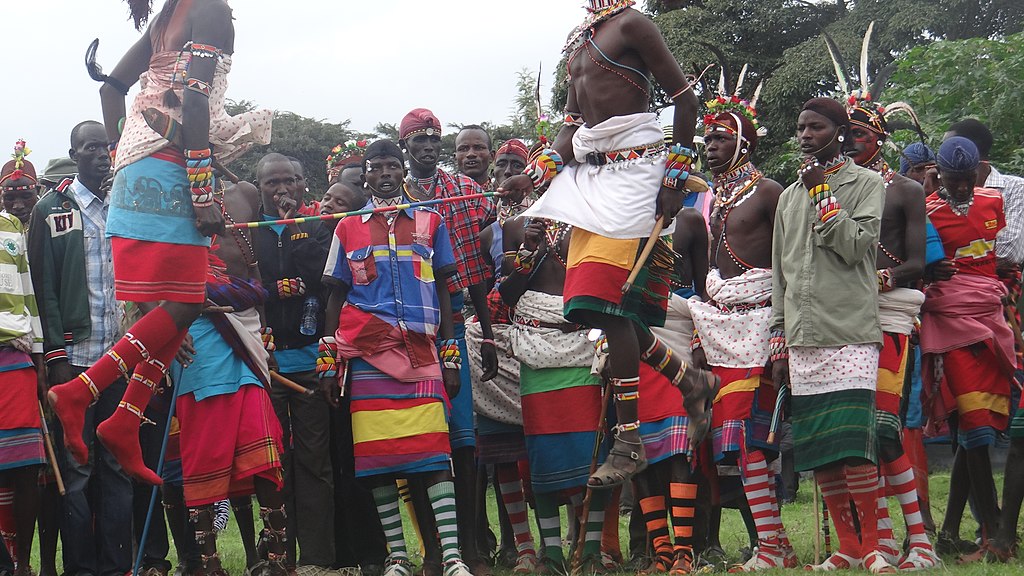 Joseph KimaniT, CC BY-SA 4.0, Wikimedia Commons
Joseph KimaniT, CC BY-SA 4.0, Wikimedia Commons
What Happens To The Girls?
Today, laws in Kenya prohibit this ritual for girls, and so it is believed to happen far less often now. But traditionally, when a Samburu girl reached the appropriate age—which was often as young as 12—she went through a circumcision ceremony as well. After that, she became available for marriage.
And while the girl’s process is much more complicated—not going through with it had consequences.
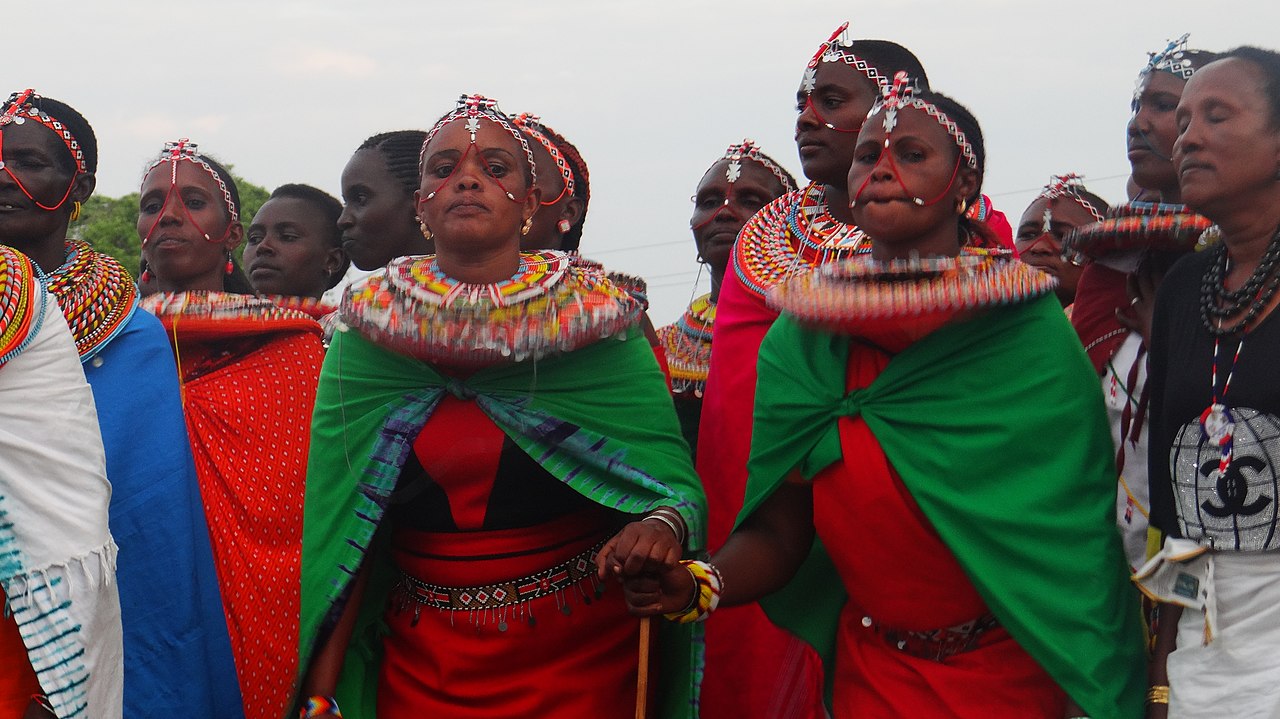 Joseph KimaniT, CC BY-SA 4.0, Wikimedia Commons
Joseph KimaniT, CC BY-SA 4.0, Wikimedia Commons
What Happens To Girls Who Don’t Partake?
While the ritual is not often up for discussion, girls who have not yet undergone the dangerous and painful procedure are at risk of being intimately assaulted as part of a practice called “beading”—another very controversial practice that should maybe come with a trigger warning.
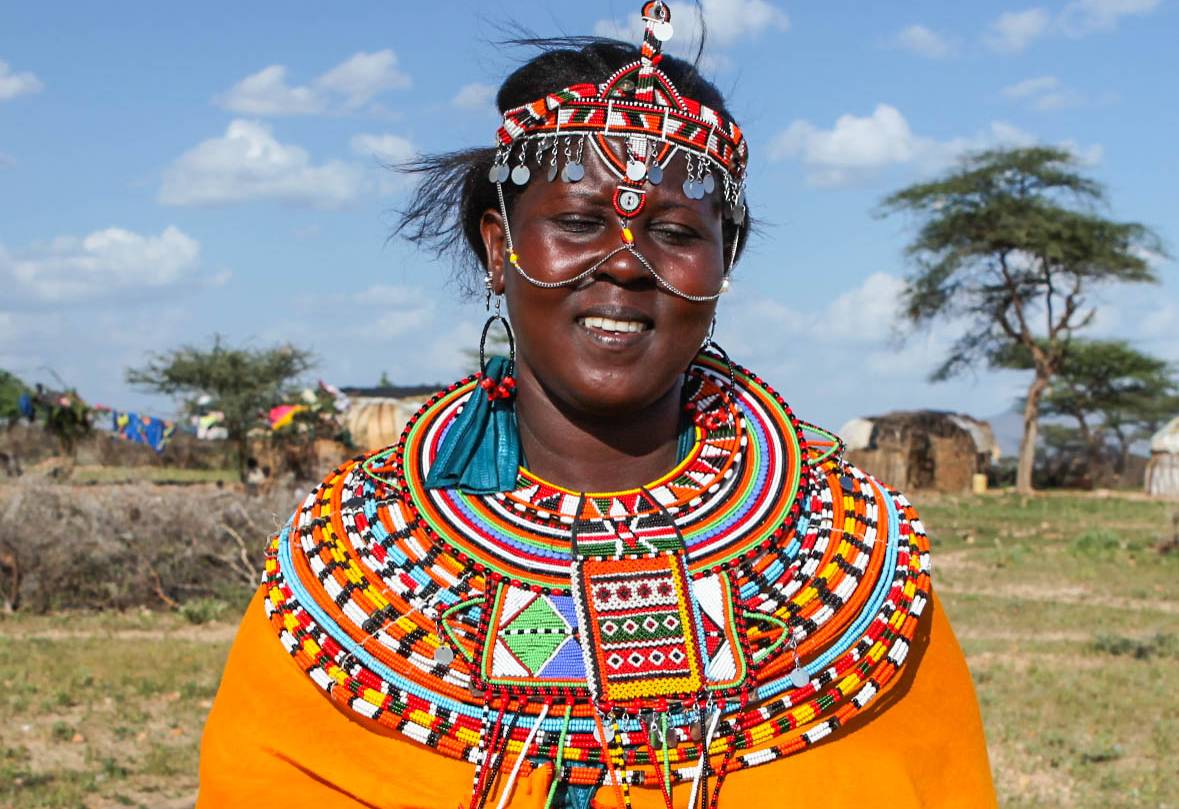 Ninaras, CC BY-SA 4.0, Wikimedia Commons
Ninaras, CC BY-SA 4.0, Wikimedia Commons
Why Is Beading Allowed?
Believe it or not, beading has a purpose, or so they claim. The Samburu elders believe that the warriors are the main defenders of the tribe, and therefore must be respected. In order for them to remain loyal in their protection, they need something worth protecting.
Thus, once they "bead" a girl, they would then be responsible for protecting her family. And, as a result, the warriors put forth more effort into protecting their tribe.
But what exactly is beading?
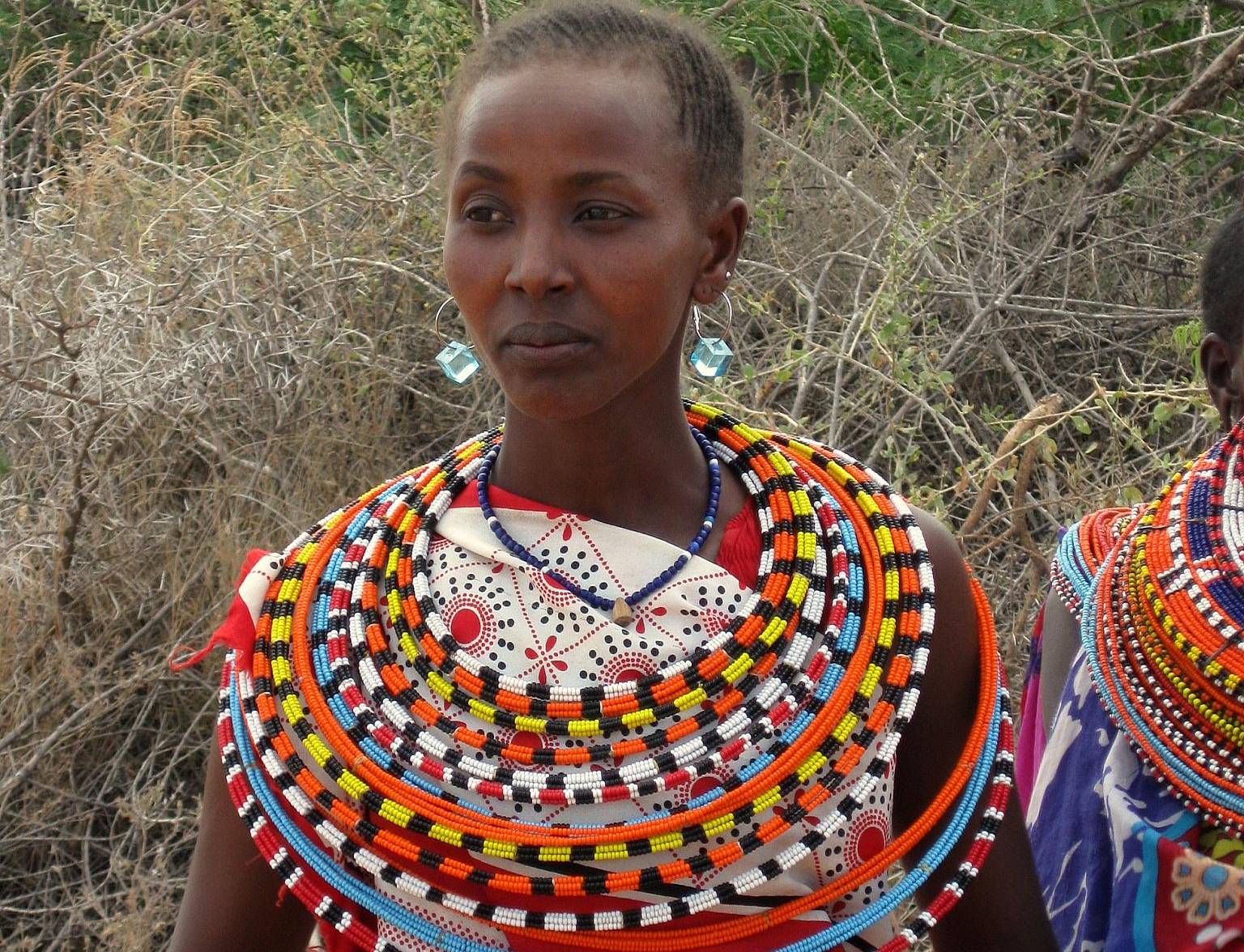 Franco Pecchio, CC BY 2.0, Wikimedia Commons
Franco Pecchio, CC BY 2.0, Wikimedia Commons
What Is Beading?
“Girl-child beading” is a cultural practice known mostly among the Samburu community which allows a non-marital intimate relationship between Samburu men in the “warrior” age group (15-30) and young girls who are not yet eligible for marriage—which is typically around the age of nine. Girls as young as four years old can be chosen, but won’t be “used” until their bodies can handle it.
If it isn’t already obvious, the girls have no say in who beads them or when.
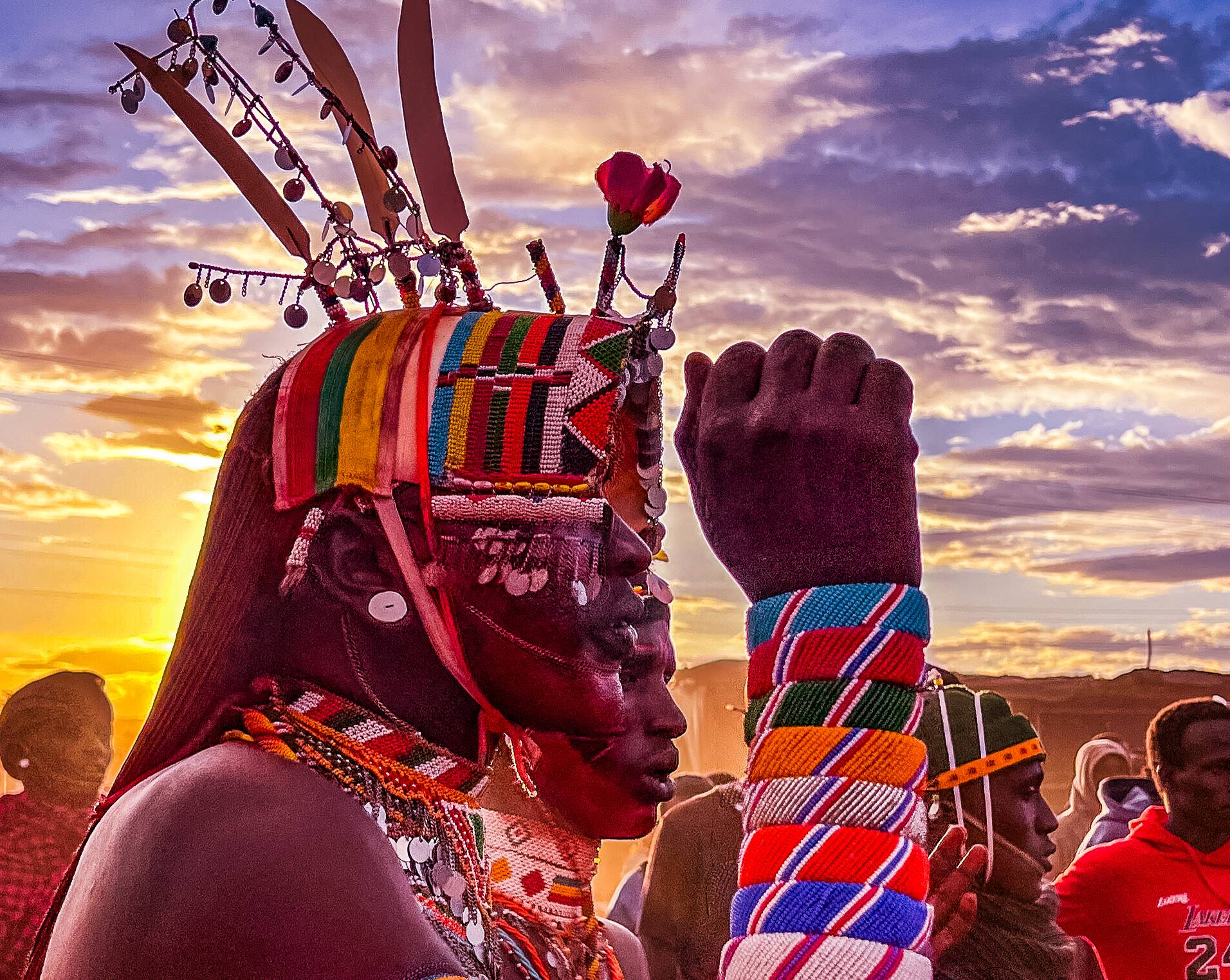 Antony Trivet, CC BY-SA 4.0, Wikimedia Commons
Antony Trivet, CC BY-SA 4.0, Wikimedia Commons
How Is Beading Initiated?
The man gives specialized beads to a young, uncircumcised girl to signify that he has officially booked her for his use. Then he must get approval from her mother, offering the family protection as a sort of trade agreement. When the mother agrees, she builds a special hut for the man to use to access her daughter anytime he wishes.
It is the Samburu's most widely practiced tradition. And while it is quite literally centuries old—it is certainly not without consequences.
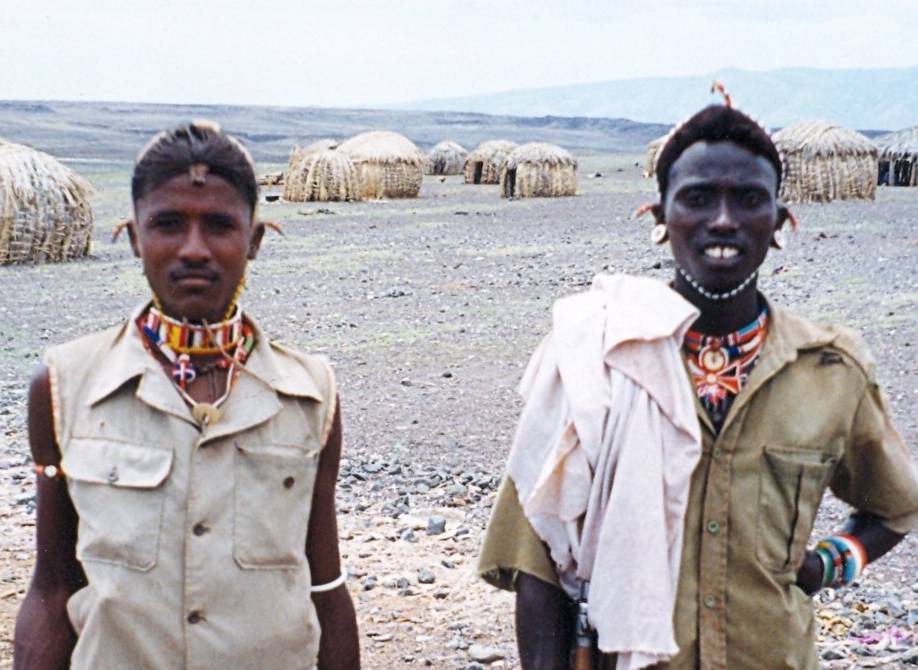 Doron, CC BY-SA 3.0, Wikimedia Commons
Doron, CC BY-SA 3.0, Wikimedia Commons
What Are The Risks With Beading?
Aside from the obvious and horrific mistreatment of young girls, beading is usually practiced among people from the same clan—AKA relatives. And so, marriage is not allowed.
But what’s worse, contraceptives are a foreign concept in many parts of Kenya—so when one of these young girls becomes pregnant, the pregnancy is either terminated or the newborn is abandoned in the forest or river, left to the predators.
 JalilArfaoui, CC BY 3.0, Wikimedia Commons
JalilArfaoui, CC BY 3.0, Wikimedia Commons
Is This Practice Tribe-Specific?
Pregnancy as a result of beading is considered one of the worst taboos for Samburu people. Their neighboring tribes also practice beading; however, the men have to choose girls who are not in their clan—which eliminates the whole incest and infanticide part.
Girl-child beading among the Samburu community has remained one of the worst silent contemporary forms of slavery. And while they still practice it today, they prefer not to talk about it.
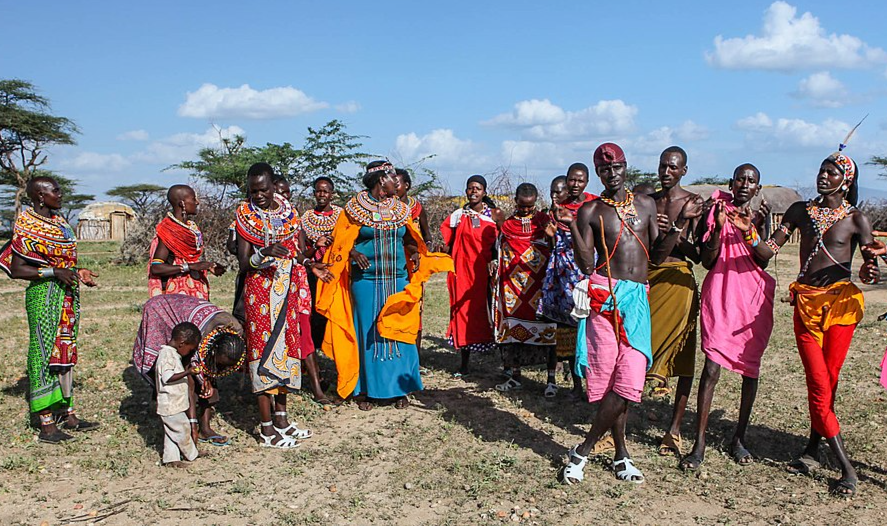 Ninara, CC BY 2.0, Wikimedia Commons
Ninara, CC BY 2.0, Wikimedia Commons
What Is Life Like For The Samburu Today?
Today, the Samburu people continue to live a semi-nomadic lifestyle, prioritizing traditional customs. And while the Kenyan government is pressuring them to settle in more permanent villages, they continue to refuse as it would completely disrupt their entire way of life.
But there is something that has changed.
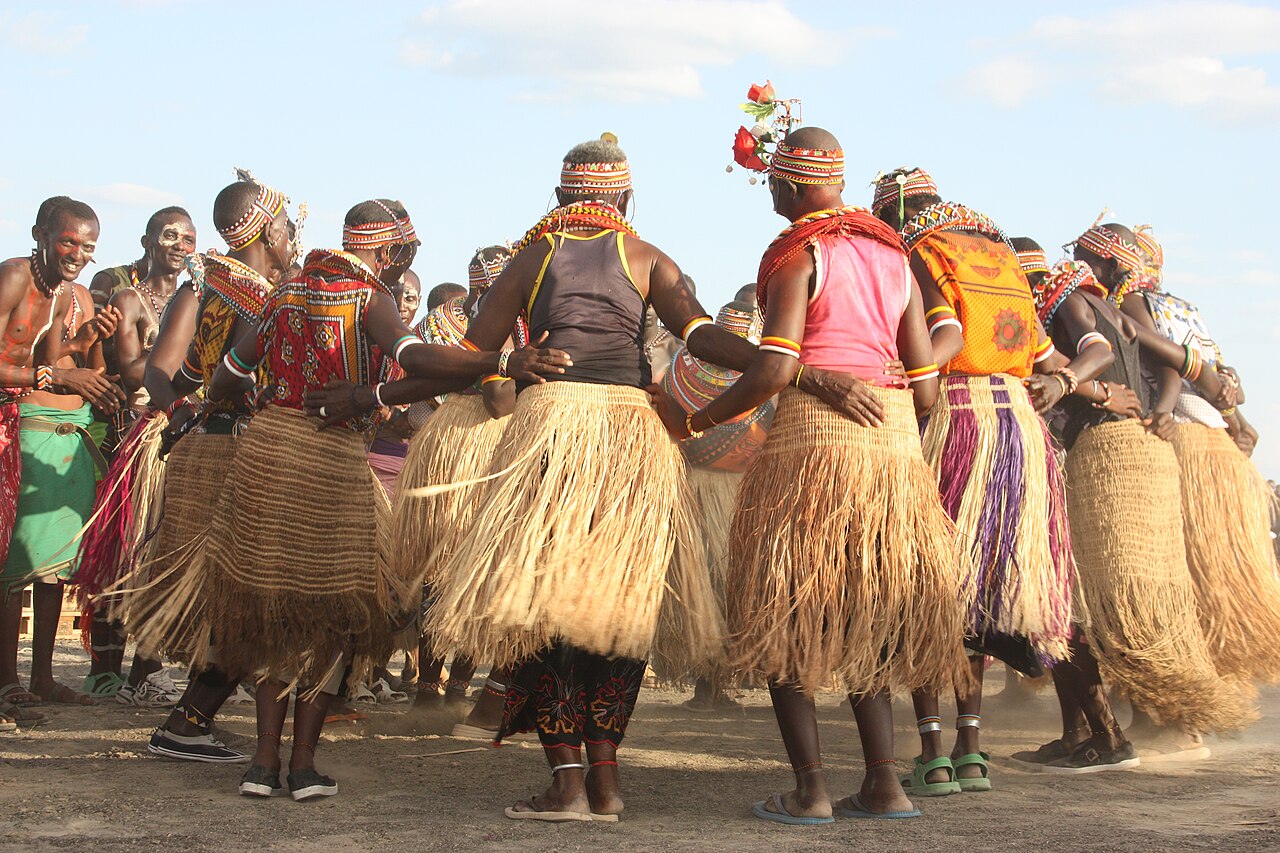 European Commission DG ECHO, CC BY-SA 2.0, Wikimedia Commons
European Commission DG ECHO, CC BY-SA 2.0, Wikimedia Commons
What Is Their Land Like Today?
Although they still live in mud huts and herd livestock, much of their land is now protected and community development initiatives have begun. Tourists can now visit parts of the Samburu community and stay in eco-friendly African lodges—that are jointly run by some of the Samburu people.
You May Also Like:
Rare Photos of the Uncontacted Amazon Tribe We Thought Was Extinct
Photos of an Isolated Tribe Living in the Amazon Rainforest
Photos of the Endangered Island Tribe in India
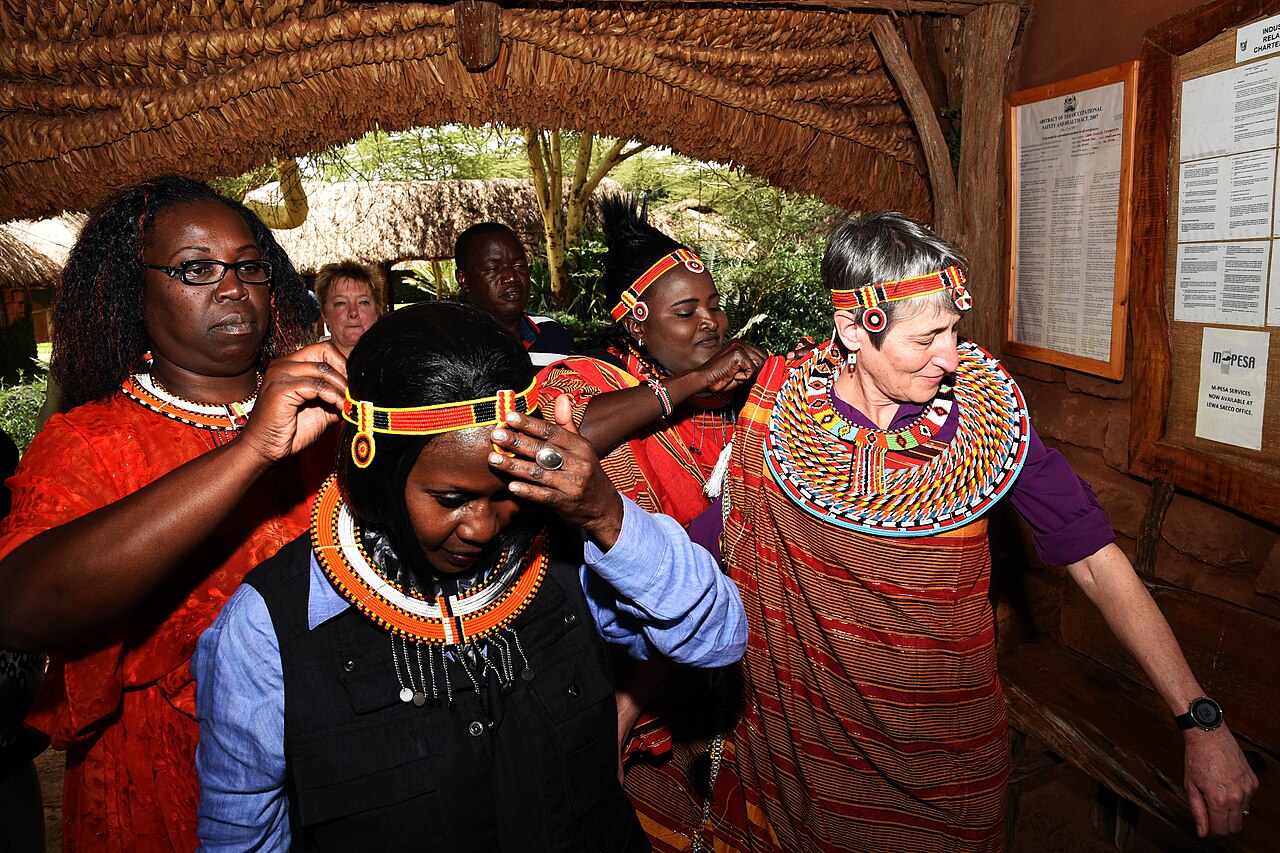 U.S. Embassy Nairobi, Wikimedia Commons
U.S. Embassy Nairobi, Wikimedia Commons

